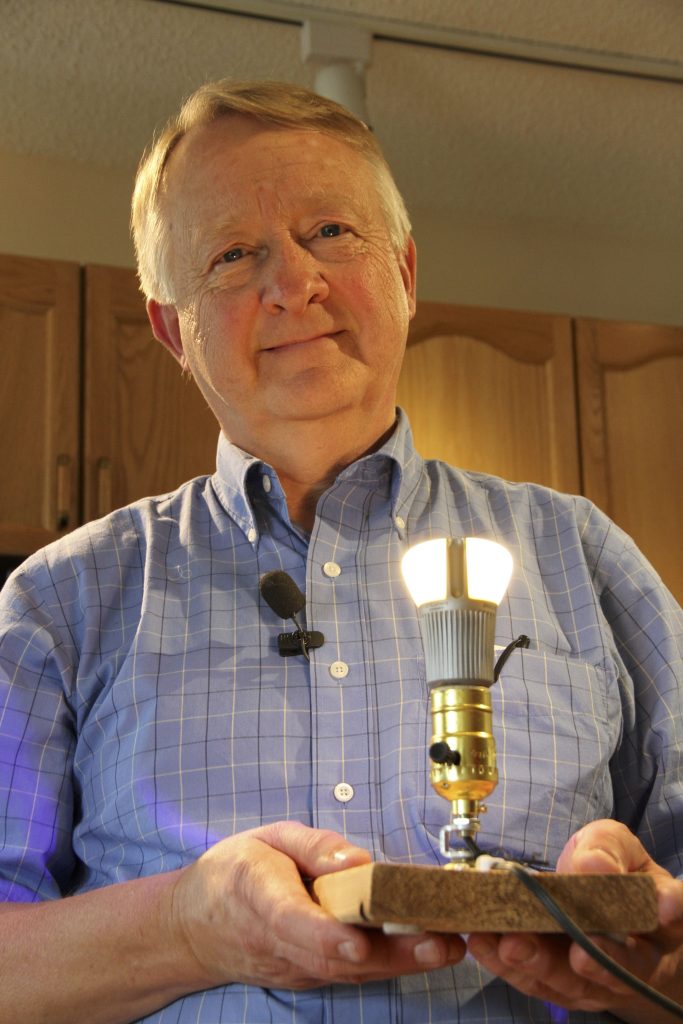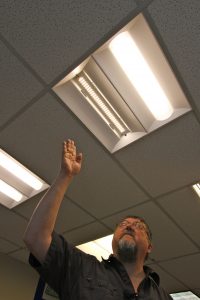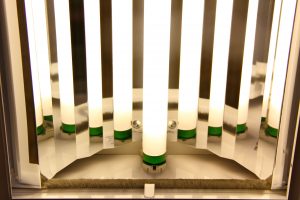By David Dodge and Duncan Kinney

Photo David Dodge, Green Energy Futures
Interviews with Wayne Rogers of Luminessence Lighting at Matthew Rogers’ home in Edmonton, Alberta
In 1812 you had to harpoon a 40-ton sperm whale and drain its oil to get a little bedside reading done. In 2012 you can flip on an LED bulb recently created by Phillips that won a ten million dollar prize.
Switching a light switch on and off may have entered society’s collective muscle memory, but the changes that are coming mean billions of dollars in savings and investments as everyone from Walmart to the Jones family makes the switch to LEDs.
According to Natural Resources Canada lighting accounts for about 11 percent of electricity use in a Canadian home. That average Canadian home also has an average of 30 light fixtures and the average Canadian spends about $130 per year on electricity to light their home.
Lighting is also the easiest and best way to use less energy. The return on investment for buying energy efficient lighting is off the charts compared to things like solar panels on your roof. They also have the distinct advantage of being a lot cheaper.
The $10 million dollar lightbulb

$10 million LED bulb – Wayne Rogers of Luminesscence Lighting pries open a Phillips 8 watt LED light to reveal six blue LED lights inside the light bulb designed by Phillips. The bulb incorporates remote phosphor technology into the plastic cover and the six blue LED lights inside excite the phosphor which emits a nice, warm, even light from this amazing light bulb. Photo David Dodge
There is no better way to illustrate the coming wave in energy efficient lighting than the story of the Phillips Ambient LED.
The Phillips Ambient LED was the very first winner of the $10 million L-Prize, an initiative by the US Department of Energy to accelerate the shift from inefficient, dated lighting to high-quality, high efficiency solid state lighting products.
It took three years for a company to win the very first L-Prize, which aimed to the replace the standard 60 watt incandescent bulb. As the 60 watt bulb makes up nearly half of American incandescent light bulb market it only made sense.
The winning bulb had to recreate the size, dimmability, light pattern and warm white glow of a regular bulb all while being five times more efficient. The trickiest part? Recreating that comfortable color temperature we’ve all grown up with. With early stage LEDs suffering from a cold, bluish cast, the engineers at Phillips came up with an interesting workaround.
It’s not easy to see the genius of the bulb until you start to take it apart. Lift up one of the three yellow plastic sections and you’ll see that the light inside is actually a piercing blue LED. That blue light emits radiation that causes phosphorous embedded in the yellow plastic to get excited and emit light. In effect using a light to turn on another light.
These bulbs currently retail between $25 and $30 dollars. However, Phillips isn’t resting on its laurels as they’ve just recently unveiled a 75 watt incandescent replacement.
The next frontier that all the major manufacturers are looking towards? The 100 watt equivalent LED bulb.
Lightbulb showdown: LEDs vs CFLs

Save tons – These 35 watt LED parking lot lights can save a ton of money when used to light parking lots. Photo David Dodge
To the casual observer all this talk about LEDs might be a bit much. After all, you probably just got used to buying compact fluorescents (CFLs). To guide you (and us!) through this tricky subject we talked to Wayne Rogers of Luminessence Lighting.
Wayne Rogers is a lighting expert, an engineer and the inventor of several successful super efficient fixtures.He’s been involved with the lighting business since the 1980s. One of his biggest projects is helping the University of Alberta do lighting upgrades over the past ten years. He’s helped them light, as efficiently as possible, about 900,000 square metres of space to date.
We asked him to break down the differences between the two most important styles of bulbs for household lighting.
Advantages of CFLs
- Cheap, mature technology – good 13 watt CFL bulbs are $2.66 each in a six pack much more inexpensive than a 12 watt LED at $30
- Solid color rendering – the warm, incandescent glow has been faithfully reproduced
- Energy efficient – LEDs and CFLs are both 4-6 times more efficient than incandescent light bulbs
- Cool to the touch – CFLs produce little heat and aren’t affected by high temperatures
Disadvantages of CFLs
- Not dimmable – Special dimmable CFLs cost more and can be unreliable
- Not effective in the cold
- Bulbs are difficult to recycle and contain traces of mercury
- Lifespan – A typical CFL lasts 10,000 hours. A typical LED? 25,000 hours. And LEDs don’t burn out like CFLs do, they just get dimmer.
- Light projection – because of their relative bulk they are not very good at projecting light across a space
Advantages of LEDs

Future fixtures – Don Cherwonka shows off an LED fixture that is ____ watts and can be controlled by computer controls. It’s a little pricy at about $300 per fixture! Photo David Dodge
- Light projection – LEDs small point light source is very effective at directing light where it needs to go
- Cold temperatures – LEDs actually perform better the colder it gets
- Lifespan – A typical LED will last 25,000 hours and never burn out compared to the CFL which typically lasts 10,000 hours
- Rapid improvements – costs are coming down and the technology is improving
- Flexible – the amount of applications where an LED will work is pretty staggering
- Good with the vibe –LEDs are ok for use in vibrating ceiling fans.
Disadvantages of LEDs
- Relatively expensive – $20 to $40 for a bulb sure seems like a lot compared to $2 to $5 for typical good quality CFLs
- Color rendering – early stage LEDs leave something to be desired when it comes to their color
- Sensitive to heat – LEDs also produce more heat than CFLs
Regardless of what you buy always look for the EnergyStar symbol. With that logo you know it will have been independently tested and that it will be more efficient than your standard bulb.
Reflected light is free

Free reflected light – Wayne Rogers designed this 96 per cent reflective fixture for a 32 watt T8 light bulb, which replaces a fixture that is less efficient and contains two 32 watt T8 fluorescent light bulbs. In other words the fixture is twice as efficient as the already efficient twin-bulb T8 fixture. Photo David Dodge
While it’s important to install energy efficient bulbs efficient fixtures and design can make much better use of less light. Proper design means a room can feel brighter and the right fixture can mean better, more effective light distribution and fewer bulbs used.
The Green Light Store is a showroom of some of the best available lighting technologies. Lighting expert Don Cherwonka devised several side-by-side comparisons to show what kind of an effect a fixture can have. T8s are skinny fluorescent bulbs that use less energy and output more light than the old fat-tubeT12 lights. T8s are among the most efficient lights on the market.
Take the typical honeycomb style 3-bulb T8 fixture that you find in banks, schools and offices around the country. They come with three fluorescent tubes but leave a lot to be desired when it comes to light coverage. By going to a 2-bulb style fixture with reflectors, you can use only two T8s and get less of a cave-like effect as more light will hit the walls given you a brighter working environment. You’re now using one third less electricity to get a better result.
In fact Wayne Rogers designed a reflector that allows you to go from your typical double T8 fixture found everywhere down to a one-bulb fixture with the help of some super reflective polished chrome (a fixture that also ends up looking really cool on film).
There are LED alternatives to the T8 lights too, but the fixtures are, at this point, quite expensive.
Sunshine the cheapest, most efficient light

Wayne Rogers prepares to show off just how much light can be harvested by a tubular skylight. Watch the video to get the full effect. Photo David Dodge
We are a sun-loving species. There is a reason the table next to the window in your favourite café is always taken, it’s because humans love natural light. It also has the quite considerable advantage of being free. All efforts should be made to include natural light in your home and office as much as possible. The advantages of natural light are numerous and well researched. It makes you more productive, it increases consumer spending in stores that use it, heck, it even makes us happy.
Integrating daylight into a building is as easy as having lots of south-facing windows but sometimes you need a little more ingenuity. Enter the tubular skylight. It’s a reflective tube that harvests sunlight from the roof and brings it as far as 16 feet down to light up an otherwise dark room with the equivalent of 200 watts of incandescent light, even more if it’s bright outside.
The Solatube is manufactured in Edmonton, but there are numerous versions and even more exciting technology in the pipe, like fiber-optic lighting which takes light from the roof and transmits it down fiber optic cable to where you want the light to go.
However you light your house remember that a light on in a room that no one is in 100 per cent inefficient, pay attention to the latest technology, use the least amount of energy possible and make sure you have quality fixtures.
On top of that remember to be thankful we don’t have to pay Captain Ahab to collect Moby Dick so we can head to the bathroom at night.
~ 30 ~





